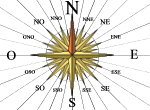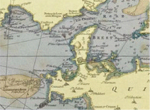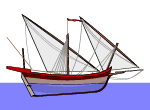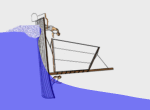
French-English glossary of nautical terms from the age of fighting sail 1780-1830
| A | B | C | D | E | F | G | H | I | J | K | L |
| M | N | O | P | Q | R | S | T | U | V | W | XYZ |
 |
 |
 |
 |
| G - French nautical vocabulary for readers of sea stories set in the period 1780-1830 | ||
| gabare (nf) : (1) voilier fluvial à fond plat, plus ou moins capable de tenir la mer (2) « bâtiment de transport ; il y en a de différentes grandeurs. Les gabares de l’état sont du port de trois à quatre cents, cinq cents et jusqu’à cinq cent cinquante tonneaux, les plus grandes ; celles de six cents tonneaux et au dessus passent dans les flûtes » |
(1) barge, lighter (a flat-bottomed sailing river boat, of variable seaworthiness) (2) small to medium-size store-ship. In the case of French transports “there are different sizes. Government gabares are of three hundred to five hundred and fifty tons burthen; those of six hundred tons or more are called flûtes“ |
|
| gabier (nm, matelot spécialisé dans la manœuvre de la voilure, surtout dans la mâture) | topman (specialist seaman who handles the sails, especially up in the rigging) | |
| gabier en chef de la hune d'artimon | captain of the mizzen top | |
| gaffe (nf) | boat-hook | |
| gagner (v, « Elle gagne au vent par rapport à nous ») | to weather ("She's weathering on us"; she's going faster to windward than we are) | |
| gaillard d'arrière (superstructure qui rehausse la coque à l'arrière du navire. Voir aussi dunette) | quarterdeck (a raised deck across the full width of the stern of a ship. See also poop-deck) | |
| gaillard d'avant (superstructure située au-dessus du pont supérieur et qui rehausse la coque à l'avant du navire) | forecastle, fo'c'sle (a structure built on the deck at the bow of a ship, forming a raised deck across the full width of the ship) | |
| gaillard > contre-maître du gaillard d'arrière | captain of the after-guard | |
| gaillard > hommes du gaillard d'arrière | after-guard (seamen whose stations are on the quarterdeck) | |
| gaine (nf, fourreau ou étui de protection pour une arme blanche) | sheath (scabbard or protective casing for a knife) | |
| galère (nf, navire propulsé à l’aviron et à la voile, déjà archaïque au XVIIIe siècle, la galère est mue par des galériens généralement condamnés. Voir tableau comparatif des bâtiments) | rowing galley (a ship propelled by oars and sail, already archaic by the 18th century, the galley was rowed by galley-slaves who were usually convicts. See vessel comparison chart) | |
| galerie de poupe (nf, balcon faisant toute la largeur de la poupe avec des fenêtres donnant sur le sillage du navire) | stern gallery (balcony across the whole width of the stern, with windows giving a view of the ship's wake) | |
| galhauban (nm, partie du gréement dormant, cordage qui soutient les mâts supérieurs par le travers et vers l'arrière. Voir aussi étai et hauban) | back-stay (standing rigging which helps support the upper masts by applying tension backwards and sideways. See also stay and shrouds) | |
| galion (nm, vaisseau de guerre espagnol, grand et lourd, à trois ou quatre mâts à voiles carrées) | galleon (large, heavy Spanish ship of war, square-rigged and with three or four masts) | |
| galiote à bombes (nf, bombarde; voilier à un, deux ou trois mâts, spécialement destiné à porter des mortiers) | bomb-vessel (sailing boat with one, two or three masts, specially designed to carry mortars) | |
| galon d'or (nm) | gold lace, braid, stripes, bands (uniform) | |
| gambes de revers (nfpl, haubanage inférieur de la plate-forme de la hune, qui part du mât ou des bas-haubans et rejoint les bords extérieurs de la hune) | futtock shrouds (the lower shrouds of the fighting-tops, which go from the mast or the lower shrouds to the outer edge of the top) | |
| garant (nm, tout cordage formant un palan et passant par une poulie; surtout le fil de tirage au sortir d'une poulie. Voir aussi palan) | falls (the rope used in a tackle; in particular the tail, the part of a rope that emerges from the block and which is hauled on. See also tackle) | |
| garcette (nf, petit cordage d’une certaine longueur qui sert à lier un objet à un autre) | gasket, lanyard (a length of thin rope or cord which is used to attach one object to another) | |
| garcette de ris | reef point, reef line | |
| garcette de tournevire (voir tournevire) | nipper (see messenger cable) | |
| garde au mouillage (nf) | anchor watch | |
| garde-côtes (nmpl, patrouille militaire) | coastguard (military patrol) | |
| gargousse - voir canon | cartridge - see cannon | |
| girouette (nf, pavillon à la tête du mât, servant à indiquer la direction et la force du vent) | vane (flag at the masthead, which indicates the direction and strength of the wind) | |
| gîte (nf, bande; inclinaison du navire sur le côté sous l’effet du vent ou de la charge) | heel, list (sideways lean of a ship under the influence of wind or distribution of load) | |
| godiller (v, faire avancer une embarcation à l'aide d'un seul aviron à l'arrière) | to scull (to propel a small boat with a single oar over the stern) | |
| goélette, goëlette (nf, normalement un petit voilier à deux mâts dont le mât à l'avant est plus court ou de taille égale au grand mât, et qui porte des voiles auriques placées dans l'axe du navire. Voir tableau comparatif des bâtiments) | schooner (usually a small sailing vessel with two masts, of which the forward mast is shorter or the same height as the rear mast, usually gaff rigged. See vessel comparison chart) | |
| goélette à hunier - voir tableau comparatif des bâtiments | topsail schooner - see vessel comparison chart | |
| golfe - voir rivage | gulf - see coastline | |
| goudron (nm, sert comme enduit pour la préservation des cordages) | tar (used as a protective treatment for ropes) | |
| goudronné (adj) | tarred | |
| gournable (nf, cheville de bois dur servant à assembler la charpente et les bordages du navire. Voir aussi cheville) | treenail, trunnel (hardwood peg used to pin together a ship's structure and planking) | |
| gouvernail (nm, voir aussi safran) | rudder, helm | |
| grade (nm, voir aussi capitaine, lieutenant, aspirant, maître, contremaître, second, matelot) | rank (see also captain, commander, lieutenant, midshipman, master, boatswain, mate, sailor) | |
| grade d'officier général | flag rank | |
| grain - voir vent | squall - see wind | |
| grand-voile - voir voile | mainsail - see sail | |
| grappin, grapin (nm) | grapnel, grappling hook | |
| gréement (nm, l'ensemble des mâts, des voiles, des vergues et des cordages qui sert à soutenir la voilure et à manœuvrer les voiles) | rigging (all the masts, sails, yards and ropes which are used to support and control the sails) | |
| gréement courant (cordage mobile qui sert à établir et à régler les voiles. Brasses, balancines, drisses, écoutes, amures, cargues, etc) | running rigging (ropes that are not fixed and are used to set and control the sails. Braces, lifts, halyards, sheets, tacks, brails, etc) | |
| gréement dormant (celui qui maintient la mâture; étais, galhaubans et haubans) | standing rigging (fixed ropes that keep the masts up; stays, back-stays and shrouds) | |
| gréeur (nm) | rigger | |
| gueule du canon (nf) | muzzle (of gun) | |
| guerre de course (la guerre contre le commerce maritime de l'ennemi, menée par des civils avec lettre de marque; voir aussi corsaire) | commerce destruction, commerce raiding (war waged against the enemy's merchant shipping, by civilians holding a letter of marque; see also privateer) | |
| guerre d'escadre (la guerre dont l'objectif principal reste la flotte ennemie) | fleet-versus-fleet warfare | |
| gui (nm, bôme; espar horizontal sur lequel est enverguée la partie basse d'une voile aurique ou triangulaire) | boom (a spar along the bottom of a fore-and-aft sail such as a gaff or stay-sail) | |
| gui de brigantine (nm) | spanker boom | |
| guindeau, guindaut (nm) | windlass | |
| guinder (v, hisser) | to hoist, to sway up | |
| guinder les mâts de hune | to send up the topmasts | |
| J - French nautical vocabulary for readers of sea stories set in the period 1780-1830 | ||
| jas - voir ancre | stock - see anchor | |
| jauge (nf, la capacité ou le volume d'un navire, par exemple, un vaisseau de cinq cents tonneaux) | burthen, tonnage (stowage capacity or volume of a ship, for example a vessel of five hundred tons burthen) | |
| jetée (nf, digue, brise-lames, môle) | jetty, breakwater, mole | |
| jeter l'ancre (v, mouiller l'ancre. Jeter l'ancre est une phrase à éviter, voir article) | to cast anchor (to anchor. Cast anchor is an expression to avoid, as discussed here) | |
| jeter un objet par-dessus bord | to throw something over the side (of a ship) | |
| jeter une cargaison à la mer | to jettison a cargo | |
| journal de bord (nm) | log book | |
| jumelé (éclissé; se dit d'un espar renforcé lorsqu'il a donné des signes de fatigue. Voir aussi voir mât consenti) | fished (splinted; said of a spar that has been reinforced after showing signs of fatigue. See also mast > strained mast) | |
| jusant (marée descendante; le mouvement descendant des eaux des mers; courant de jusant. Voir aussi flot) | ebb tide (falling tide; sea level going down; outgoing current. See also flood) | |
| K - French nautical vocabulary for readers of sea stories set in the period 1780-1830 | ||
| ketch (nm, voilier aurique à deux mâts, dont le mât d'artimon / arrière est plus petit, et muni d'un beaupré assez long. Voir tableau comparatif des bâtiments) | ketch (small sailing vessel with fore-and-aft sails rigged on two masts, of which the mizzen mast is shorter. Also has a fairly long bowsprit. See vessel comparison chart) | |
| L - French nautical vocabulary for readers of sea stories set in the period 1780-1830 | ||
| lacet (nm, d'un navire, mouvement de rotation autour de l'axe vertical; embardée. Voir aussi tangage et roulis) | yaw (of a ship, rotation around the vertical axis; the bow sheering from side to side. See also pitch and roll) | |
| lagune - voir littoral | lagoon - see coastline | |
| « Laissez courir !» - voir nager | "Trail oars!" - see rowing | |
| lame (nf) | wave | |
| lame de fond | groundswell | |
| lance-amarres (nm, ligne d'attrape | heaving line | |
| lancer (v) (1) d'un navire, mettre à l'eau (2) d'un objet, jeter en avant |
(1) to launch a ship (2) to throw an object |
|
| larder (v, passer des bouts de fils de caret sur une face d'une voile afin de garnir un seul côté). On larde une bonnette « avec des bouts de fil de caret pour être placée sous la carène d'une bâtiment; on suive le lardage et elle sert à aveugler provisoirement une voie d'eau trop considérable » |
to fother (to thread many short lengths of rope yarn in and out of one side of a sail to make a one-sided mat) One fothers a studding sail with ends of rope yarn so that when secured beneath the ship’s hull it will reduce an excessive leak. |
|
| large (nm, haute mer) | the open sea (the high seas) | |
| au large | offshore | |
| au large d'Ouessant | off Ushant | |
| se mettre au large, naviguer vers le large | to make your offing | |
| largue (nm, allures portantes où le navire reçoit le vent largue ou à peu près de travers) | large (this expression is now seldom used in English; one talks instead of wind on the beam. Those points of sailing where the vessel receives the wind side-on or thereabouts) | |
| grand largue (allure portante se rapprochant du vent arrière) | wind on the quarter, quartering wind, broad reach (point of sailing where the ship receives the wind over the quarter) |
|
| une mer grande largue (houle de trois-quarts arrière) | a quartering sea (swell from behind and somewhat to the side) | |
| larguer (v, détacher, laisser aller): (1) larguer les amarres (2) larguer les voiles |
to let go (to release or detach) (1) to cast off, to let go the mooring lines (2) to unfurl the sails, to make sail |
|
| « Larguez les amarres ! » | "Let go the moorings !" | |
| latine - voir voile | lateen - see sail | |
| latitude (nf, distance de l’équateur. Les lignes de latitude sont parallèles. La hauteur du soleil à midi local permet de déterminer la latitude du vaisseau. Voir aussi longitude) | latitude (distance from the Equator. Lines of latitude are parallel. A ship’s latitude can be calculated by the height of the sun at local noon. See also longitude) | |
| lest (nm, tout ce qui peut servir à alourdir et ainsi assurer la stabilité d'un navire) | ballast (anything which can contribute to a ship's stability by weighing it down) | |
| « Lève rames ! » - voir nager | "Rowed of all!" - see rowing | |
| levier (nm) | crowbar, lever | |
| lieue marine (nm, trois milles marins, 5550 mètres) | league (three nautical miles, 5550 metres) | |
| lieutenant (nm) | lieutenant | |
| premier lieutenant | first lieutenant | |
| lieutenant de vaisseau | commander | |
| ligne d'attrape (nf, voir lance-amarres) | heaving line | |
| linguet, élinguet (nm, cliquet; languette en bois ou fer dont la fonction est d’arrêter le cabestan ou guindeau) | pawl (click, part of a ratchet; tongue made of wood or iron, the purpose of which is to brake a capstan or windlass | |
| lisse (nm, appui, garde-fou) | (guard) rail | |
| lisse de couronnement (lisse de la poupe) | taffrail (rail at the poop) | |
| lit-hamac (nm, lit d'officier) | hanging cot (officer's bed) | |
| littoral (nm) | shore, coastline | |
| littoral > accore (adj, se dit d'une côte immédiatement bordée de fonds importants) | steep-to (adj, said of a coast with deep water right up to the edge) | |
| littoral > anse (nm) | cove, small bay | |
| littoral > archipel (nm) | archipelago, cluster of islands | |
| littoral > baie (nf) | bay | |
| littoral > banc de sable (nm) |
sandbank | |
| littoral > banc de vase (nm) | mudbank | |
| littoral > barre (nf, banc de sable à l'embouchure d'un fleuve) | bar (sandbank at the mouth of a river) | |
| littoral > cap (nm, pointe de terre élevée qui s’avance dans la mer) | headland, point, cape | |
| littoral > continent (nm): (1) l’Asie, l’Europe, etc (2) terre ferme par rapport aux îles voisines |
(1) continent (Asia, Europe, etc) (2) the mainland |
|
| littoral > crique (nf, petite baie où de petits bateaux peuvent se mettre à l’abri) | creek (in British English, an inlet where small craft can shelter) | |
| littoral - détroit (nm, pas; canal entre deux terres rapprochées) | narrows, straits (channel between two nearby pieces of land) | |
| littoral > écueil (nm, récif, une chaîne de rochers à fleur d'eau. Voir aussi fond) | reef (rocks at or near the surface. See also shoal) | |
| littoral > embouchure (nf, endroit où un fleuve se jette dans la mer) | river mouth | |
| littoral > estuaire (nm, embouchure d’un fleuve qui forme une sorte de baie large, longue et soumise aux mouvements de la marée) | estuary (river mouth in the form or a wide, long bay that is affected by the tides) | |
| littoral > étang (nm, plan d'eau douce ou saumâtre, peu profonde, soit continental, soit séparé de la mer par un cordon littoral de galets ou de sable) | lagoon (area of shallow fresh or brackish water, sometimes inland, sometimes separated from the sea by a bank of shingle or sand running parallel to the coast) | |
| littoral > falaise (nf) | cliff | |
| littoral > golfe (nm, large baie) | gulf (large bay) | |
| littoral > goulet (nm, entrée étroite d’un port ou d’une rade) | narrows, mouth (narrow entrance to a port or roadstead) | |
| littoral > grève (nf, plage) | beach | |
| littoral > île (nf) | island | |
| littoral > îlot (nm) | small island | |
| littoral > isthme (nm) | isthmus | |
| littoral > lagune (nf, plan d'eau salée ou saumâtre, peu profonde, séparé de la mer par un cordon littoral de galets ou de sable, généralement percé de passes) | lagoon (area of shallow salt or brackish water, separated from the sea by a bank of shingle or sand running parallel to the coast, usually with gaps open to the sea) | |
| littoral > péninsule (nf, promontoire étroit; une île rattachée au continent par un isthme, une zone relativement moins large qu'elle) | peninsula (narrow promontory; an island attached to the mainland by an isthmus, in other words a narrower strip of land) | |
| littoral > plage (nf) | beach | |
| littoral > presqu'île (nf, une île rattachée à la terre par un isthme, une zone relativement moins large qu'elle) | peninsula (an island attached to the mainland by an isthmus, in other words a narrower strip of land) | |
| littoral > récif (nm, écueil, une chaîne de rochers à fleur d'eau. Voir aussi fond) | reef (rocks at or near the surface. See also shoal) | |
| littoral > rivage (nm) | shore | |
| littoral > seuil (nm, haut-fond à l'embouchure d'un fleuve ou fjord) | bar (shallows across the mouth of a river or fjord) | |
| loch, loc (nm, une planchette triangulaire se laissant aller à la mer au bout d'un câblot sur lequel des nœuds sont marqués de distance en distance; en liaison avec un sablier de demi-minute ou quart de minute, il permet de mesurer la vitesse d'un navire) | log, log line (a triangular piece of wood attached to the end of a line which is knotted at intervals. The wood is thrown over the side, and the number of knots paid out in a time measured with a thirty-second or fifteen-second hourglass is a measure of the ship's speed through the water) | |
| filer le loch | to heave the log, to cast the log | |
| lofer (v, remonter dans le lit du vent, naviguer plus près du vent) | to luff up (to steer so that the bow points more to windward) | |
| long (nm) | length | |
| le long de la côte | coastwise, along the coast | |
| le long du bord d'un navire | alongside a ship | |
| longitude (nf, distance à l'est ou à l'ouest du méridien de Greenwich ou de Paris. Pour ceux qui ont un sextant et aussi un chronomètre réglé sur l'heure du méridien origine, l'heure exacte de la position la plus haute du soleil dans le ciel à midi local permet de calculer la longitude du vaisseau. See also latitude) | longitude (distance east or west of the Greenwich or Paris meridian. For those who have a sextant and also a chronometer set to the time of the prime meridian, a ship’s longitude can be calculated by reference to the exact time of the sun’s highest position in the sky at local noon. See also latitude) | |
| longue vue (nf) | telescope, glass | |
| lougre (nm, voilier léger à deux ou trois mâts, gréé avec des voiles au tiers. Voir tableau comparatif des bâtiments) | lugger (a light sailing boat with two or three masts carrying lugsails. See vessel comparison chart) | |
| loup de mer (nm, vieux marin expérimenté) | old salt, sea dog (experienced old sailor) | |
| louvoyer (v, remonter contre le vent au plus près, en virant souvent de bord, adoptant une trajectoire en zigzag) | to tack to windward (to sail upwind, close-hauled, changing tack so that the ship's course is a zig-zag) | |
| lover (v, enrouler une corde en cercles superposés) | to coil, to cheese down (to put a rope into neat superimposed loops) | |
| lumière - voir canon | priming-hole or vent - see cannon | |
| lunette de longue vue (nf) | telescope, glass | |
| lunette de nuit (« Les verres sphériques larges sont très bons pour faire des lunettes de nuit ; les Anglais ont construit des lunettes de cette espèce, et ils s'en servent avec grand avantage pour voir de fort loin les vaisseaux dans une nuit obscure» Buffon, 1835) | night-glass ("Large spherical lenses are very good for making night glasses; the English have made telescopes of this sort and they use them to great advantage to see ships from far off on dark nights" Buffon, 1835) | |